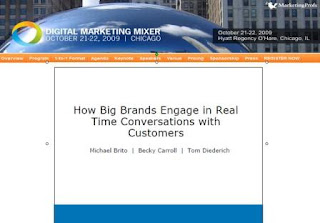
In my last post about
Sigma's Fuel For Thought, the Growth & Innovation Series,
John Battelle discussed the Conversation Economy and how marketing is everyone's job. In a breakout session, Pete Spande - also from
Federated Media, continued the discussion and shared examples.
[Pete also writes
Continuous Beta.]
The Evolving Conversation Economy
In his presentation, Pete Spande reminded us that we're in a period of evolution rather than revolution. Conversation has always driven consideration, but we've simply forgotten this for a while.
Furthermore, we don't have a neat funnel. Rather, we have complexity at the center of the funnel. No one size fits all; it varies per customer. However,
social/conversation media combined with a vendor message influences buying decisions.For an advertiser, though, the
conversation needs to be at scale.
Conversation at scale means harnessing social media to create conversations with your customers - offering value that dovetails with the social media publisher you advertise with. As
Federated Media describes it, it's built on Conversational Media: "
we believe that the best conversations are those where all parties are engaged, informed, and valued. Working with our marketing and publishing partners, Federated Media is helping to define this innovative form of online marketing: a three-way dialog among creators, audiences, and marketers."
According to the Forrester who developed the Social Technographics Ladder,
Social technology growth marches on in 2009, led by social network sites. More specifically "
in 2009, more than four out of five online Americans are active in either creating, participating in, or reading some form of social content at least once a month." As the chart below illustrates, the level of conversation is increasing consistently.

The question becomes, particularly for brands: how to be part of the conversation economy?
One answer lies with Federated Media which manages over 150 premium properties including:
-
Heather Armstrong's
dooce.com-
Ree Drummond's
Confessions of a Pioneer Woman-
Business Insider and
Henry Blodget,
Kevin Ryan,
Julie Hansen,
Dan Frommer-
Pete Cashmore/
MashableThese are all major media properties that built their audiences organically, have successfully engaged via the social web customers [e.g., via comments, time invested on site, voting, sharing, etc.], thereby amplifying messages through sharing and building significant equity.
From what Federated has observed, the common denominator is
content:
- that resonates strongly with a specific audience
- that picks-up conversations already in progress; this is a direct offshoot of listening
- that amplifies shared values between the site and its visitors
- that invites a response/sharing
In short, it's content that creates conversation [remember, this is the conversation economy!].
For example, Mashable.com published a post about
4 Ways News Organizations Are Using Twitter Lists. 3 hours after it went live, it had generated 20 comments. As of 12/8/09, it has been ReTweeted 1268 times, and
strong search equity for "news organization use Twitter" [i.e, page 1 on Google in position #1 or 2].
Take a
search for chocolate milk recipe.
Pioneer Woman's post about Decadent Chocolate Milk appears on page one. It has also generated as of 12/8/09, 1467 comments. Wow!
And, for a brand to successfully partner with these conversations, it must:
+ be promoted in a way that makes sense or meaning,
+ appeals to large, diverse groups in an extremely relevant way,
+ if relevant, calls for a small simple task [e.g., a RT - ReTweet]
5 case studies : How to use conversation as a marketer?
1. The Conversationalist Ad Unit
American Express Open Forum where content is used in an ad unit. Note the bottom of the page and the wealth of options relevant to small and medium businesses. The results: 5-15% interaction rate and a click through ~3x average ad unit performance.
FM details on Open Forum.
Unfortunately, I couldn't find a link to show this to you. However, FM created resource centers for Samsung with curated content combined with Conversationalist ad units that included CNET pricing information. To accommodate this unusual approach, the landing page was rethought to help with the purchase decision.
By the way, a benefit of the conversationalist ad unit is that content remains fresh.
3. Suave/Dooce Community Offers Shared Communal Affinity
The
dooce community recently [i.e., early November 2009] launched with 5000 signing up on the first day. Not bad! Federated Media created the site with Suave as sponsor. You'll notice a range of interactive branding elements, from ad units that invite you to learn more, to statements about Suave that are ready for ReTweeting.
4. WePC [Asus] --> entered US 2 years ago therefore had no baggage
Asus entered the US PC market 2 years ago. As a result, it had no baggage yet ample opportunity! The
WePC site allows visitors to dream about their ideal PC and submit ideas. Asus took some of those ideas and integrated them into their next generation product. The company learned that it had to lean into other communities to get submissions. For example, it sponsored an art context with the
Facebook Graffitti application to envision what future technology would look like; it received approx. 5000 submissions.
Explore the WePC site. You'll notice video clips and opportunities to vote or discuss ideas and concepts. What a way to engage PC users.
FM details on WePC.
[Other
Facebook Graffitti contest: BMW 1 Series]
5. ExecTweets
ExecTweets captures the best executive Tweets. It's designed for selfishness, allowing followers to consume the information as preferred. With over 1 million followers, it captures relevance. The
ExecTweets website page also includes sponsored sidebars. It also adds value to existing conversations, embraces what customers using, provided options to give customers control of the experience [note that you can select industries], and it builds and supports assets to build longterm value.
FM details on ExecTweets.[Here is a link to the
Federated Media Guide to Conversational Marketing.]
I found Pete Spande's presentation fascinating. For the most part, I find digital ads clunky and irrelevant. These examples made more sense to me given their relevance and level of engagement. I'm not surprised that they deliver results.
What are your reactions? What kind of digital ad units do you click on? What success have you seen with your digital ad efforts?
Technorati Tags: conversation economy federated media sigma fuel for thought exectweets wepc dooce community open forum samsung netbooks social media marketing advertising Del.icio.us Tags: conversation economy federated media sigma fuel for thought exectweets wepc dooce community open forum samsung netbooks social media marketing advertising





























